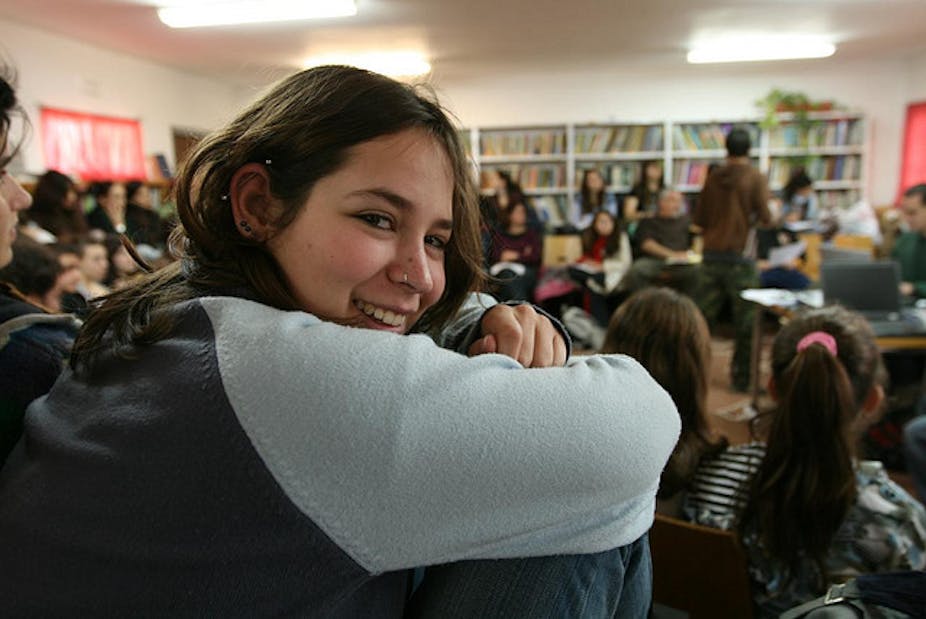Imagine a school where the students have equal say with the teachers, principal and governors in all areas of school life. Their say is not limited to being school or house captain, prefect or a member of the Student Representative Council. They have the power to decide how the school runs, in some cases even to hire and fire staff.
Now imagine a school where students would be able to opt in or out of individual classes, to choose what and when they study, and could decide which classes they attend. Theoretically, they could do any class they wanted on any given day and up and leave part way through if they wanted. However, they could still work towards a tertiary entrance score that would allow them to follow pathways into post-school education and training.
Welcome to the world of democratic schooling.
What are democratic schools?
Democratic schools exist in Australia. In Queensland, there is the Pine Community School, the Brisbane Independent School, Maridahdi, the Booroobin Sudbury School and the Blackall Range Independent School. In New South Wales, there’s Currambena and Kinma. Victoria has the Hurstbridge Learning Coop, the Sherbrooke Community School and Village Independent School.
Most of these schools cater for primary to year 7 students. However several, including those in Victoria (Village and Sherbrooke) and in Queensland (Blackall Range), offer Prep to Year 12 education.
Students who attend these schools could, theoretically, never have to experience teachers having more say over their education than they do. They generally attempt to match children’s learning with the national curriculum. They do so not by testing the students, rather by looking at what the children are learning and making links to the curriculum documents.
These schools, like all “private schools”, are funded by federal government expenditure and private fees. Often, as these schools may not collect enough in fees, they engage in other fund-raising activities.
There are three types of democratic schools. Those modelled on the Summerhill School in the UK, Sudbury Schools modelled on those schools located in the Sudbury Valley, USA, and Anarchistic Free Schools (yes, from the word anarchy). The latter have not been without controversy.
While Democratic schools are philosophically different, they have more in common with the unschool movement than they do with traditional, formal schools and are a reaction to those schools. Daily life in the classrooms varies and is determined by the children’s interests. Some schools hold a weekly meeting with the children to vote on the week’s activities and focus.

The history of democratic schools
Possibly the most famous democratic school, and the oldest, is Summerhill School in the UK. It was started by AS Neil in 1921 in Suffolk. One of the reasons this school is famous is because of its fight with the UK government.
In 2000, the Department for Education and Employment threatened the school with closure because its Office for Standards in Education inspection was damning. The inspectors demanded major changes to the philosophy that governed the school. Specifically, they did not support the “free child” philosophy of the school and wanted to impose more control over the students.
The school developed a concerted campaign to save itself and wound up at the Royal Courts of Justice in London. It is now the only school with an inspection process that includes staff and student input.
The Sudbury School is the most famous US example of a democratic school. The US has 35 Sudbury Schools and one is in the process of being established in Sydney. The first Sudbury School was established in 1968 after a group of parents and educational experts decided to establish a school where the focus was on children establishing their own meanings through learning what they wanted to learn. The Sudbury Model shares much with the unschooling philosophy.
Benefits
Studies suggest graduates of democratic schools are no less successful in tertiary education than their traditionally educated peers. One report on Sudbury Schools suggests graduates have a more positive attitude towards learning, enjoy study more than traditionally schooled peers and have higher self-esteem.
Another report suggests over 80% of Sudbury alumni graduated from further education. Similarly, at Summerhill, a study found 100% of parents strongly agreed that the school encouraged “children to get involved in more than just their daily lessons” and that it had a positive effect on students.
Pitfalls
One of the major problems has to be explaining the education to friends and family. Traditional education shares little in common with the free model espoused by democratic schools and, it must be imagined, people are perplexed by the system. I imagine many friends and relatives would sit somewhere on a spectrum from bemused to horrified.
Home educators often criticise these schools for trying to unschool by proxy and for failing to live up to their goals. Most of the democratic schools set up in the 1960s and 1970s failed.
Do they work?
Answering questions about whether they work implies comparisons between democratic and mainstream schools are possible. Comparing them is difficult as democratic schools don’t test their students. For example, Australian students enrolled in democratic schools would generally not take the NAPLAN tests that most students complete.
However, they offer a choice to parents looking for something different, and the campaign to open a Sudbury School in Sydney suggests we may be hearing more about democratic schools in the future.
This is part of a series on Alternative Schooling. Read the other articles in the series here. If you have any ideas on alternative types of schooling you’d like to know about, or write about, please contact The Conversation.

